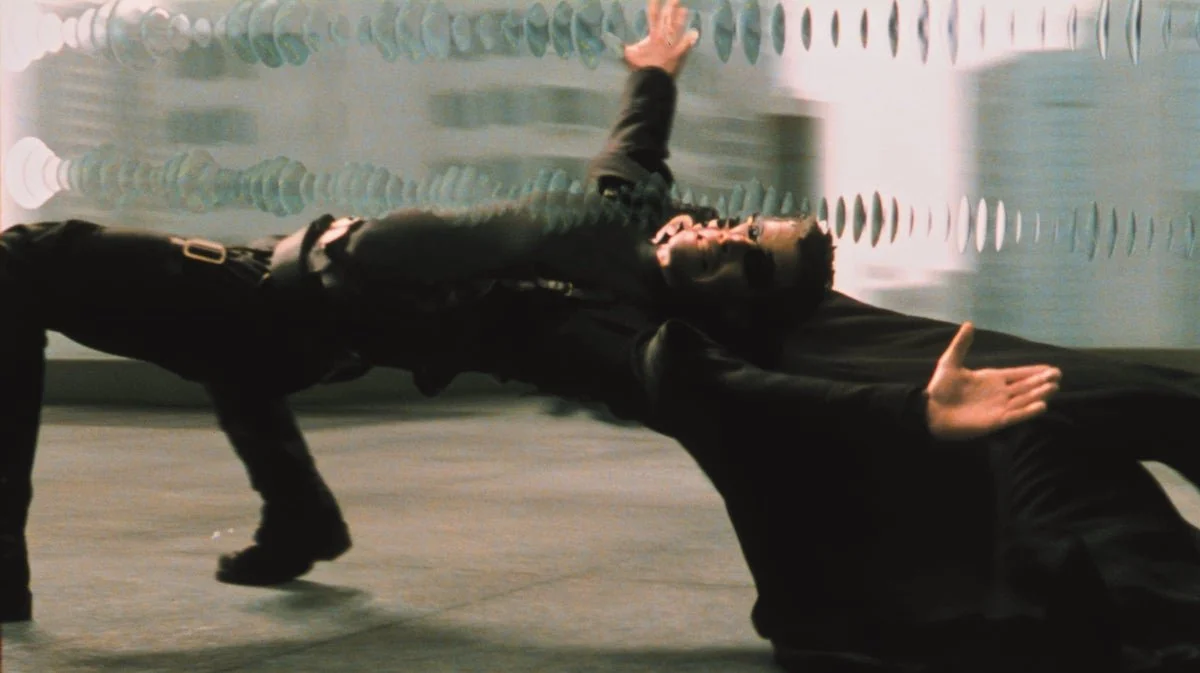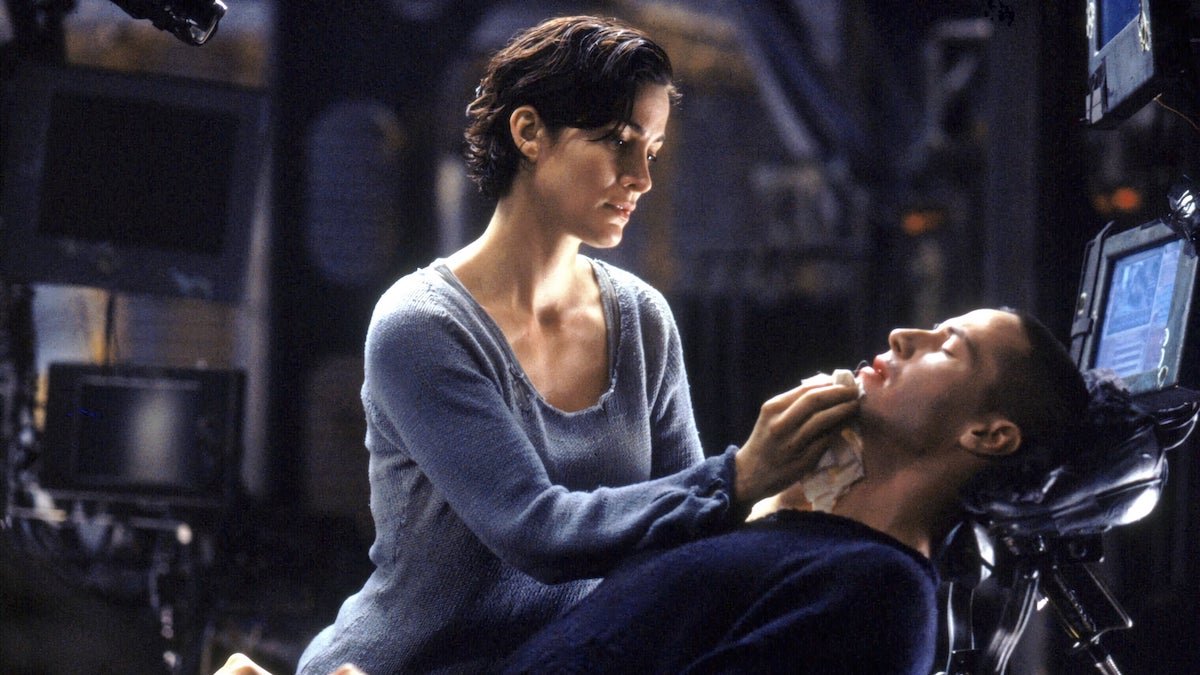Follow The Rabbit
Gamechanging sci-fi, queer classic, alt-right rallying cry – The Matrix is many things to many people. To coincide with the release of The Matrix Resurrections, Rachel Pronger heads down the rabbit hole to unpick the strange history of Lilly and Lana Wachowski’s original Matrix movie.
What is The Matrix? It’s a question that recurs throughout the Wachowskis’ seminal sci-fi film, a question upon which a universe hinges and opens. But it’s something that audiences, critics and even the filmmakers themselves have continued to ask over the two decades since The Matrix was released.
Somehow, this bombastic, brilliant blockbuster has become a prop in an ongoing culture war. To find out how The Matrix became so polarising, we have to head down a rabbit hole, through a looking glass and into the darkest depths of the internet. So, hold tight, and follow the white rabbit…
A sci-fi gamechanger
At the start of 1999, Star Wars: The Phantom Menace was the year’s most anticipated blockbuster; by the end, two upstarts had stolen George Lucas’s thunder. The Wachowskis’ success came from leftfield. The sisters’ debut feature, 1996’s Bound, had received generally good reviews and performed respectably at the box office, but their follow-up propelled them to new heights. Watching The Matrix today is still mind-blowing; back in 1999, audiences didn’t know what had hit them.
The film follows Neo (Keanu Reeves), an office drone/closet hacker who spends his nights searching the web for the answer to a question that’s haunted him his entire life - what is The Matrix? When Neo is contacted by legendary outlaw Morpheus (Lawrence Fishburne) he finally gets his answer. In one of the most famous scenes in cinema, Morpheus presents Neo with two pills and a choice:
You take the blue pill the story ends, you wake up in your bed and believe whatever you want to believe. You take the red pill, you stay in Wonderland, and I show you how deep the rabbit hole goes.
Neo, naturally, takes the red pill and discovers the truth. Which is, to put it as simply as possible, that Earth is a dystopia ruled by machines who keep humans as slaves, harnessing their energy for power. The Matrix is the virtual reality that the machine overlords use to maintain control – as humans lie hooked up like batteries in the “real world,” their minds roam The Matrix, living lives that feel real, but are in fact just simulations. Neo, although understandably a bit confused, joins Morpheus’s band of rebels and sets out to fight for the emancipation of humankind in a series of dizzying action sequences.
The Matrix’s combination of dazzling design, spectacular actions and an array of references - Alice in Wonderland, Zen Buddhism, Greek myths, martial arts movies - captivated audiences and critics alike. The film went on to win four Oscars, and to have an incalculable impact on the next generation of action movies. Darren Aronofsky, Quentin Tarantino and Christopher Nolan are all self-confessed fans, and effects pioneered by the Wachowskis – such as bullet-time and flo-mo – have become genre mainstays cropping up everywhere from Charlie’s Angels to X-Men to Shrek. The film’s success encouraged studios to fund other ambitious projects helmed by comic book obsessives, ushering in the era of Marvel and DC. It’s hard to imagine mainstream cinema today without The Matrix.
The alt-right’s favourite meme
By the late 2000s, turn-of-the-millennium optimism had been overshadowed by a decade dominated by 9/11, the War on Terror and the financial crisis. In 2003, the Wachowskis had released two Matrix sequels which did well financially but received mixed reviews. While the franchise remained influential, audiences were beginning to move on. Then, things got weird.
Around 2012, a subreddit called TheRedPill appeared. It’s still active today, although in order to access it you need to pass through an ominous “quarantine” page which warns you to beware of “highly offensive material.” This is because TheRedPill is part of the manosphere, a collection of websites run by various acronym-abusing male-centric groups, including men’s rights activists (MRAs), Men Going Their Own Way (MGTOWs), pickup artists (PUAs) and incels. These groups share a pro-male, anti-feminist agenda and overlap with the alt-right, another motley coalition of lurkers encompassing QAnon, neo-Nazis and anti-vazzers among others.
In this grubby digital bunker, The Matrix became a talisman. TheRedPill takes as a starting point that famous scene between Morpheus and Neo, only this time the truth revealed is that we live in a gynecocracy, with men as the true victims of gendered inequality. For “redpillers” The Matrix’s anti-establishment message inspired a movement that uses the pretext of non-conformity to encourage hate, conspiracy theories and radicalisation.
The meme spread like a virus through the alt-right corners of the internet. To be “redpilled” came to symbolise being awakened to any number of right-leaning revelations – a “white genocide” being covered up by communists perhaps, or the existence of lizard people. Red pill forums became a gathering point for Donald Trump supporters and played a key role in Trump’s election. The meme infiltrated the mainstream, cropping up in tweets from Kanye West and Elon Musk.
Although this ubiquity has rendered the red pill increasingly meaningless in recent years, the story of how The Matrix became an alt-right symbol reveals the impossibility of controlling how art is received. For the Wachowskis, as well as for the film’s stars, it’s been frustrating to see The Matrix appropriated in this way. Producing potent cinematic symbols is an unpredictable game.
Imagery from 2005’s V For Vendetta for instance, which was written and produced by the Wachowskis, has been referenced by both far-left hacktivists Anonymous and far-right anti-Black Lives Matter protestors. Yet while it’s impossible to control how your work is received, it’s true too that art is always open to new readings - and as the Wachowkis have discovered, the best way to reclaim the narrative is to offer a new interpretation of your own.
A queer, feminist classic
Around the same time the alt-right took the red pill, the Wachowskis began to publicly present as trans women. The language around trans identity is limiting – as Lana has put it, transition can be a troubling word because of “its complicity in a binary gender narrative.” However, while acknowledging these linguistic limits, it’s important to recognise the Wachowski’s transitions as a turning point for perceptions of The Matrix. At the very least, knowing Lilly and Lana’s identities automatically turns it into the most successful trans-directed film ever. But this knowledge also helps unpick the intrinsic queer and feminist politics woven into the film’s fabric.
Once you see the queerness of The Matrix it’s impossible to unsee. This is a film, after all, about a double life. By day Neo passes as an obedient employee; by night he seeks out fellow deviants on the internet to unlock the truth about his identity.
Queerness saturates every element. The villainy of Agent Smith (Hugo Weaving) is obvious in his aggressive use of Neo’s deadname “Mr Anderson.” In one memorable throwaway moment, Cypher (Joe Pantoliano) warns Neo to prepare for his journey by referencing stock queer text The Wizard of Oz – “Buckle your seat belt Dorothy, Kansas is going bye bye.” The film’s lushly camp design leans heavily on LGBTQ+ subcultures. Neo is part of an underground scene that dons fetish wear – leather coats, PVC trousers, harnesses – to congregate in BDSM bars. It plays on the double meaning of the word bondage – both the state of slavery (like humans kept in bondage by machines), and a sexual practice closely associated with queer kink.
This queer coding is complemented by an unusually diverse cast. One character, Switch, was originally intended to flip gender between scenes. While this detail didn’t make the finished film the character remains strikingly gender-neutral. Elsewhere, gender slippages are commonplace. “I thought you were a guy” are Neo’s first words on meeting the androgynous hacker Trinity (Carrie-Anne Moss). “Most guys do,” she replies nonchalantly. Trinity gets many of the most dynamic action sequences, including a lengthy opening in which she holds off multiple men single-handed, securing her status as a feminist action heroine for the ages.
And it’s not simply the case that the Wachowski’s transitions imbue The Matrix with retrospective queerness; that reading was there all along. In 2020, Lilly confirmed that she always intended the film as a trans allegory. When viewed within the span of the sisters’ careers, it becomes even clearer that The Matrix is part of a queer body of work which spans the lesbian romance of Bound, the fluid identities of Cloud Atlas and Sense 8, and the ferocious camp of Jupiter Ascending.
Ironically, even the red pill itself is probably an explicit trans reference – in the 1990s, the oestrogen pills prescribed to trans women were maroon.
Whatever you want it to be
The Matrix’s contested history touches upon a truth: film is in the eye of the beholder. Depending on your perspective, Neo is an alt-right troll, an Anonymous hacker and/or a closeted trans person. The Wachowskis themselves seem sanguine about the unpredictability of audiences. “We as human beings engage with art in a non-linear way,” Lilly has said, “We can always talk about something in a new way, in a new light.” For The Matrix’s LGBTQ+ fans, the films never belonged to the alt-right, and confirmation that the sisters always intended it to speak to them is a welcome endorsement.
The Matrix Resurrections is released in cinemas on December 22.
Rachel Pronger is a writer, curator and producer, and co-founder of feminist film collective Invisible Women.
Sign up to our mailing list and you’ll be sent our latest Storyboard post every week with The Friday Read. Mailing list subscribers are also automatically entered into our weekly competition to win one of five pairs of cinema tickets, so it’s truly a win-win scenario.




